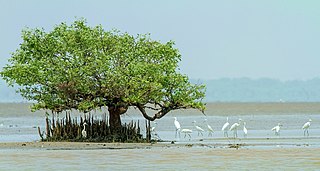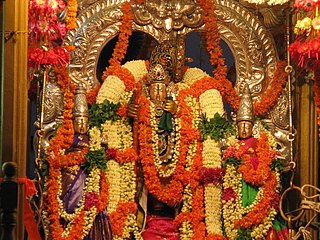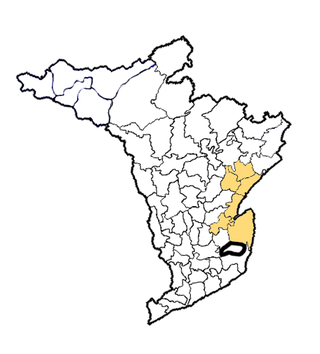
The Bay of Bengal is the northeastern part of the Indian Ocean, bounded on the west and northwest by India, on the north by Bangladesh, and on the east by Myanmar and the Andaman and Nicobar Islands of India. Its southern limit is a line between Sangaman Kanda, Sri Lanka, and the north westernmost point of Sumatra, Indonesia. It is the largest water region called a bay in the world. There are countries dependent on the Bay of Bengal in South Asia and Southeast Asia. During the existence of British India, it was named as the Bay of Bengal after the historic Bengal region. At the time, the Port of Kolkata served as the gateway to the Crown rule in India. Cox's Bazar, the longest sea beach in the world and Sundarbans, the largest mangrove forest and the natural habitat of the Bengal tiger, are located along the bay.

The Godavari is India's second longest river after the Ganga river and drains into the third largest basin in India, covering about 10% of India's total geographical area. Its source is in Trimbakeshwar, Nashik, Maharashtra. It flows east for 1,465 kilometres (910 mi), draining the states of Maharashtra (48.6%), Telangana (18.8%), Andhra Pradesh (4.5%), Chhattisgarh (10.9%) and Odisha (5.7%). The river ultimately empties into the Bay of Bengal through an extensive network of tributaries. Measuring up to 312,812 km2 (120,777 sq mi), it forms one of the largest river basins in the Indian subcontinent, with only the Ganga and Indus rivers having a larger drainage basin. In terms of length, catchment area and discharge, the Godavari is the largest in peninsular India, and had been dubbed as the Dakshina Ganga.

East Godavari is a district in the Coastal Andhra region of Andhra Pradesh, India. Its district headquarters is at Rajahmundry. As of census 2011, it became the most populous district of the state with a population of 5,151,549.

Coastal Andhra also known as Kostha Andhra is a region in the state of Andhra Pradesh, India. Vijayawada is the largest city in this region. It was part of Madras State before 1953 and Andhra State from 1953 to 1956. According to the 2011 census, it has an area of 91,915 square kilometres (35,489 sq mi) which is 57.99% of the total state area and a population of 34,193,868 which is 69.20% of Andhra Pradesh state population. This area includes the coastal districts of Andhra Pradesh on the Circar Coast between the Eastern Ghats and the Bay of Bengal, from the northern border with Odisha to Tirupati district in the South.
Kakinada is the sixth largest city of the Indian state of Andhra Pradesh and serves as the district headquarters of the Kakinada District. It lies on the coast of the Bay of Bengal. J.N.T.U. College of Engineering Kakinada, established in 1946, is the oldest and popular Government college in the state of Andhra Pradesh. The First Polytechnic college of Andhra Pradesh, Andhra Polytechnic was established here in 1946. It was also the origin point of Buckingham Canal where goods used to be transported by boats during the British rule. It was once home for Asia's largest sea port. Many people from the city migrated from this sea port to countries like Burma, Mauritius, Fiji and various southeast Asian countries to work there as workers where they were called as Coringas.

Coringa Wildlife Sanctuary is an estuary situated near Kakinada in Andhra Pradesh, India. It is the third largest stretch of mangrove forests in India with 24 mangrove tree species and more than 120 bird species. It is home to the critically endangered white-backed vulture and the long billed vulture. Mangroves are a group of trees and shrubs that live in the coastal intertidal zone, with a dense tangle of prop roots that make the trees appear to be standing on stilts above the water. This tangle of roots allows the trees to handle the daily rise and fall of tides; hence, the mangrove forest gets flooded at least twice per day. The roots also slow the movement of tidal waters, causing sediments to settle out of the water and build up the muddy bottom.

Konaseema is a group of islands between the tributaries of the Godavari River and Bay of Bengal located in Dr. B.R. Ambedkar Konaseema district of Andhra Pradesh in southern India. It is nicknamed "Gods Own Creation" due to similarities with the Kerala backwaters.

Narasapuram, or Narsapur, is a Town in West Godavari district of the Indian state of Andhra Pradesh. It is a municipality and mandal headquarters of Narasapuram mandal in Narasapuram revenue division. The city is situated on the banks of the Vasista Godavari River. The lace industry is prevalent in the city and its surroundings.

Kakinada (rural) mandal is one of the 21 mandals in the Kakinada district of the state of Andhra Pradesh, India. It has its headquarters at Kakinada. The mandal is bounded by Samalkota mandal, Pedapudi mandal, Karapa mandal, Kothapalle mandal and waters of Bay of Bengal.

Andhra Pradesh is a state in India. Andhra Pradesh Tourism Development Corporation (APTDC) is a state government agency which promotes tourism in Andhra Pradesh, describing the state as the Koh-i-Noor of India. Andhra Pradesh has a variety of tourist attractions including beaches, hills, caves, wildlife, forests and temples.

Devi river is one of the principal distributaries of Mahanadi. It flows through Jagatsinghpur district and Puri district across Odisha state in India and joins Bay of Bengal.

Krishna Godavari Basin is a peri-cratonic passive margin basin in India. It is spread across more than 50,000 square kilometres in the Krishna River and Godavari River basins in Andhra Pradesh. The site is known for the D-6 block where Reliance Industries discovered the biggest natural gas reserves in India in 2003.

Uppada is a village in East Godavari district of the Indian state of Andhra Pradesh. It is located in Kothapalli mandal of Kakinada revenue division. Uppada Jamdani Sari is a handcrafted sari woven at the village and is also a geographical indication of Andhra Pradesh. It is popular Fishery station for Prawns.

Very Severe Cyclonic Storm Lehar was a tropical cyclone that primarily affected the Andaman and Nicobar Islands and the Indian state of Andhra Pradesh. Lehar was the second most intense tropical cyclone of the 2013 season, surpassed by Cyclone Phailin, as well as one of the two relatively strong cyclones that affected Southern India in November 2013, the other being Cyclone Helen.

The coastline of Andhra Pradesh is located on the southeast coast of the Indian Peninsula, and forms a part of the Northern Circars, with waters in Bay of Bengal. It has the second longest coastline in India next to Gujarat, with a length of 975 km (606 mi). The coastal corridor consists of several ports, harbours, vast stretches of sandy beaches, wildlife, bird sanctuaries, fresh water lakes and estuaries.
Kakinada (urban) mandal is one of the 21 mandals in Kakinada district of the state of Andhra Pradesh, India. It has its headquarters at Kakinada city, that covers the entire mandal. The mandal is surrounded by Kakinada (rural) mandal and lies on the coast of Bay of Bengal.

The 1996 Andhra Pradesh cyclone was a small but powerful storm that left heavy damage in the Indian state of Andhra Pradesh. It formed on 4 November in the eastern Bay of Bengal. Moving westward, it quickly organized and developed a well-defined eye. On 6 November, the cyclone struck about 50 km (30 mi) south of Kakinada, Andhra Pradesh at peak intensity. The India Meteorological Department estimated peak winds of 145 km/h (90 mph), while the American-based Joint Typhoon Warning Center (JTWC) assessed peak winds of 215 km/h (135 mph). Soon after landfall, the cyclone weakened and dissipated by 7 November.
The Dolphin Nature Conservation Society (DNCS) is a registered voluntary environmental non-profit and non-governmental organization (NGO) located in Visakhapatnam, Andhra Pradesh, India. It is committed to the causes of nature conservation, environmental protection, research, education, and awareness. The society was founded on March 5, 2001, by Dr. Mantha Rama Murty and Dr. Mangathayi, who had previously launched several nature conservation programs in Andhra Pradesh, particularly in Visakhapatnam. The organization's activities are intended to instill a love for nature and conservation among people, especially among the younger generation. Notable research, documentation, conservation, and awareness campaigns of the society have involved Olive-Ridley Sea Turtles, intertidal rocky shore fauna and flora of the Visakhapatnam coast, and butterflies of the Eastern Ghats. The society's flagship project is the development and maintenance of the Biodiversity Park in Visakhapatnam.
On 25 November 1839, the port city of Coringa in Andhra Pradesh on the southeastern coast of British India was battered by a tropical cyclone that destroyed the harbor. Known as the 1839 Coringa cyclone and sometimes also referred to as the 1839 India cyclone and 1839 Andhra Pradesh cyclone, its storm surge caused wide damage. It killed over 300,000 people, making it the second-deadliest storm worldwide after the 1970 Bhola cyclone. Many ships were destroyed and houses were washed out by rising rivers and streams. Croplands were inundated and many animals drowned due to the floods and storm surge.

Kakinada district is a district in the Coastal Andhra Region in the Indian state of Andhra Pradesh. With Kakinada as its administrative headquarters, it was proposed on 26 January 2022 to become one of the resultant twenty six districts in the state after the final notification has been issued on 4 April 2022 by the government of Andhra Pradesh. The district was formed from Kakinada and Peddapuram revenue divisions from East Godavari district. Incidentally, during earlier times, the region comprising towns Pithapuram, Kakinada and Peddapuram were referred as Polnaud or Prolunadu, which now roughly corresponds to the areas in this district.
















